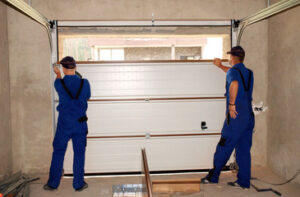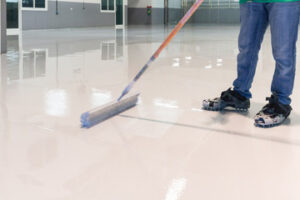Garage Door Repair involves repairing, replacing, and maintaining the equipment that supports the operation of a garage door. This includes springs, torsion assemblies, tracks, bearings, rollers, and automatic openers. Garage door technicians need to have technical knowledge, problem-solving skills, physical dexterity, and a willingness to follow detailed instructions and diagnostic manuals.

A damaged panel is one of the most common issues homeowners encounter with their garage doors. Whether it’s from normal wear and tear or an accident, a panel that is scratched, dented, bent, or otherwise compromised can significantly affect the function and appearance of the door.
Fortunately, there are several repair options available when it comes to garage door panels. Depending on the nature of the damage, and the severity, you may be able to simply repair it with a bit of filler and paint, or in some cases, replacement might be necessary.
To determine the best course of action, it’s important to first assess the damage and determine if it affects the structural integrity of the door. Minor dents and scratches aren’t necessarily a cause for concern, but larger cracks or bends can compromise the structure of the door and pose a safety risk.
For any significant or extensive damage, it’s best to enlist the help of a professional Orange County garage door repair company. They’ll be able to provide you with the right advice and guidance and can perform any repairs or replacements required quickly and effectively.
To begin, it’s important to take accurate measurements of the damaged panel and to order replacement panels that are a perfect match for the existing ones. It’s also crucial to disconnect the power and secure the door before beginning any work. Finally, when it comes to installing the new panels, make sure to handle them carefully to prevent any additional damage. Once the new panels are in place, it’s important to test the functionality of the door and make any necessary adjustments. Proper maintenance will ensure that your garage door remains in good working condition for years to come.
Misaligned Tracks
Misaligned tracks aren’t just annoying; they can be dangerous for your door and your personal safety. Over time, a variety of things can cause your garage door tracks to become loose or out of alignment. Loose bolts, environmental factors (like temperature changes), or improper installation can all lead to track misalignment. Fortunately, there are a number of simple steps you can take to fix the problem on your own.
First, listen closely as your garage door moves up and down on its tracks. Identify any positions where you hear a rubbing noise; this is a sign that the rollers are encountering more friction than is necessary in that spot. You can then use a wrench to loosen the track bolts and move the tracks back into their correct position. Be careful not to over-tighten, as this could strip the bolts or damage the track. Then, use a level to ensure that the tracks are perfectly vertical and horizontal.
If you’re unable to repair the tracks on your own, it’s best to call in the professionals. They have the tools and experience to do a thorough job, ensuring safe operation and longevity for your garage door. Regular track alignment also helps prevent the deterioration of other parts of your door, like the rollers, hinges, and opener, extending their lifespan and minimizing expensive repair costs in the future.
Broken Rollers
The rollers, located on the tracks on both sides of your garage door, are responsible for smooth and controlled opening and closing. They are made of steel or nylon and designed to withstand repeated use and minimal friction. When you start noticing that your garage door makes excessive noises or jumps off its track, it’s likely time to replace your rollers.
To make sure you’re purchasing the right replacement rollers, it’s best to measure them before installing them. Specifically, check the diameter, length and stem length to ensure your new rollers will fit your current garage door and work seamlessly with your garage door opener.
In addition to replacing your rollers, you’ll also want to inspect the tracks for any signs of damage or misalignment. Minor collisions with vehicles or debris can bend or warp your tracks, and this can throw off the balance of your entire system. To prevent additional issues, it’s a good idea to straighten your tracks with a hammer or track tool before continuing your garage door repair.
Before you begin removing and replacing your garage door rollers, turn off the opener to prevent anyone from accidentally opening or closing the door while you’re working on it. Once your safety precautions are in place, disconnect the power cord from your garage door opener and remove the screws on both hinge brackets that hold the rollers in place. Once you’ve removed the old rollers, carefully pry them up out of their mounts and place your new rollers in their places. After completing your repairs, manually test the door to ensure it operates smoothly.
Broken Springs
One of the most common causes of a broken garage door is worn springs. Springs offset the weight of the door and allow it to be opened and closed easily, either by hand or with an automatic opener. Over time, the high-tension steel in these springs will lose their effectiveness and need to be replaced. When they break, the garage door will likely become crooked and won’t open or close correctly. Broken springs also often loosen the cables, which can cause other problems.
Homeowners often attempt to replace their own garage doors’ springs, but this is usually a job best left to the professionals. Working with springs that are under such high tension is dangerous and requires special tools. Additionally, the springs can snap if not handled properly. If you’re planning to try replacing your own garage door’s springs, make sure to follow the instructions provided by the manufacturer of your door.
There are two types of garage door springs: extension and torsion. Extension springs are long, skinny springs that run parallel to the horizontal tracks of the door. They store energy by extending or stretching when the door is opened. Torsion springs, on the other hand, are mounted above the garage door using a pulley and eyebolt. They are available in two different styles: open-looped and double-looped. Open-looped springs have an open wire at the end, while double-looped springs have two coils that connect to the moveable pulley and eyebolt.
Both types of springs can be damaged by rust, corrosion or just normal wear and tear. They’re also rated for only a few thousand cycles – or openings and closings – before needing to be replaced. Over the course of a single day, many households go through a minimum of two cycles just getting their cars in and out of the garage. This repeated use can lead to a broken spring in just a few months.
Broken Hardware
When parts like hinges, shafts, rollers and drums break it can have a big impact on your garage door’s functionality. Depending on the type of break, these parts might need to be repaired or replaced completely. For major hardware repairs, it is usually best to leave the job to a professional garage door repair technician. This will help you avoid making further damage and ensure the repair is completed correctly.
It is also recommended that you don’t attempt to work on any broken components with an open or moving door. This can result in further damage to your garage door and even pose a safety risk for you or anyone else. If you’re working with a broken door, always disconnect the power from the opener unit before you start working on the broken component. This will prevent accidental activation while you are trying to fix it.
Minor issues like squeaky hinges may be easy enough to resolve on your own, but if you’ve tried to reduce the squeaking and it hasn’t worked, it’s probably time to call a professional. These professionals have the tools, parts and knowledge needed to get your garage door back to functioning properly as soon as possible.
If you have a door that opens and closes but doesn’t engage with the motor, this is likely because of an issue with the sensor lenses. These are often blocked by dirt or something placed directly in front of them. Cleaning the sensors and ensuring they are aligned is a quick repair that can be done by yourself without the need for professional assistance. However, more serious problems requiring the replacement of gears and belts should be handled by an experienced technician to minimize potential damage to other parts.
